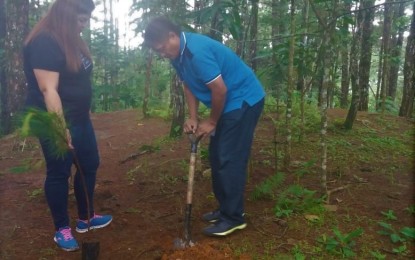
TREES FOR QUAKE VICTIMS. Philippine News Agency (PNA) reporter Pamela Mariz Geminiano is assisted by People's Television employee Romy Paloga in planting a pine tree seedling at the Busol Watershed on Monday (July 16, 2018) in memory of those who perished in the killer quake that rocked northern Philippines exactly 28 years ago. (Photo by Liza T. Agoot)
BAGUIO CITY -- Government workers and members of the media in Baguio City planted 100 pine trees at the Busol Watershed on Monday in memory of those who perished in the killer quake that rocked northern and central Philippines 28 years ago.
Dexter See of the City Information Office told the participants that the tree planting is part of the Eco-Walk activity conceived in 1992 by the Baguio Correspondents and Broadcasters Club (BCBC) led by then city information officer Ramon Dacawi.
The local government adopted the tree-planting initiative as an environmental awareness activity of the city's Disaster Risk Reduction Management (DRRM) program through the City Information Office.
City Information Office chief Aileen Refuerzo said based on the story of her former head, Ramon Dacawi, the tree-planting activity was conceptualized as a memorial to those who died in the 1990 killer quake that left 1,283 people dead and 321 missing.
The Baguio City government adopted the activity instead of making a memorial wall with the names of those who perished in the quake.
During the Eco-Walk, a native ritual was also conducted. A pig was butchered the traditional way and offered to “kabunyan” (god) to prevent a repeat of a similar disaster.
"The tree symbolizes the perished soul," said Joseph Zambrano of the Philippine Information Agency (PIA) Cordillera, who regularly joins the Eco-Walk at the Busol Watershed.
The Busol Watershed provides about 40 percent of the water used by Baguio residents. It has a total land area of 336 hectares, with 224 hectares located within La Trinidad, Benguet, while 112 hectares is situated in Baguio.
"It all started during an Eco-Walk with school children organized by Ramon Dacawi, when he asked the children where water comes from," Zambrano said.
Dacawi, he continued, was surprised when the children answered, saying, "It comes from the faucet." He said Dacawi asked again where water from the faucet comes from, and the children said it comes from the tank.
Dacawi then realized that school children should be educated about natural resources. He then explained that the water that comes from the faucet and tanks are being extracted from forest grounds.
Dacawi, a native of Ifugao, adopted the "Muyong System", which in the tuwali dialect means "forest".
“People who plant the seedlings will always come back to nurture the plant and to take care of the environment,” Zambrano said. This, he pointed out, is a disaster-prevention measure in itself.
"This is the first pine tree I planted," Mihai, a student from Isabela who participated in Monday's Eco-Walk, said. "This is very special to me because tomorrow is my father's death anniversary and I want his memories to continue living in us through this tree."
Mihai and the other Eco-Walk participants recited the "Forest Friend's Pledge", promising "to be a friend, to visit my friend, to strengthen this bond by caring for the tree seedling that I planted, so that it will grow tall and robust and green and healthy and when I do, I will gift my friend with another tree."
The Eco-Walk program won for Baguio City the 1996 “Galing Pook” Award, bestowed by the Asian Institute of Management and the Department of the Interior and Local Government.
Children’s environmental immersion into how forests sustain life was made a model throughout the world. Its effectiveness was cited by the United Nations Environmental Program, which conferred on the children’s project its 2002 Global 500 Award. (PNA)
